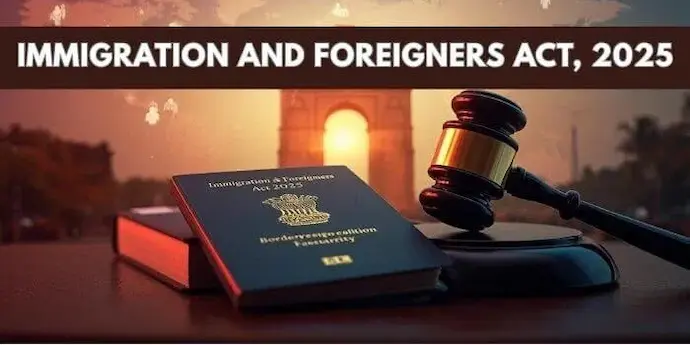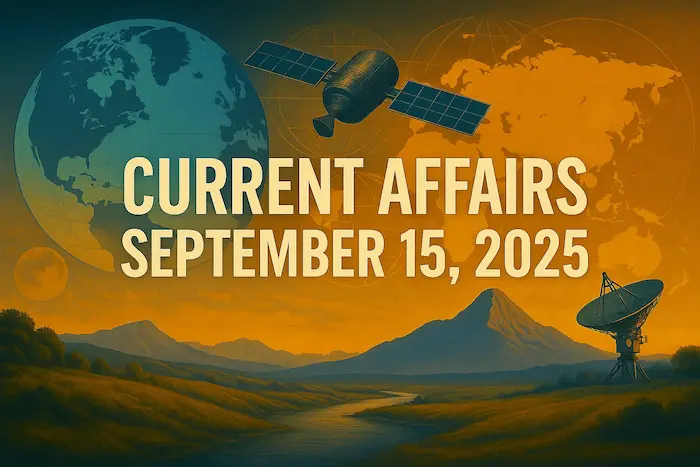1. Enhanced Powers of Foreigners Tribunals under Immigration and Foreigners Act, 2025 – Polity

What is the News?
- The Union Home Ministry has implemented the Immigration and Foreigners Act, 2025, replacing several outdated laws and empowering Foreigners Tribunals (FTs) with enhanced judicial authority.
- This streamlines immigration governance and addresses modern security and administrative challenges.
Key Details / Background:
- Repealed Laws:
- Passport (Entry into India) Act, 1920
- Registration of Foreigners Act, 1939
- Foreigners Act, 1946
- Immigration (Carriers’ Liability) Act, 2000
- Bureau of Immigration (BOI):
- Now empowered to investigate immigration fraud.
- Maintains a centralized immigration database.
- Collaborates with state authorities on identification and deportation.
- Biometric Mandate:
- All foreigners must submit biometric data, widening the scope of surveillance and documentation.
- Reporting Obligations:
- Educational institutions must report attendance and conduct of foreign students to the FRRO.
- Powers to Shut Premises:
- Establishments found sheltering illegal migrants can be closed down under legal orders.
- Judicial Powers to Foreigners Tribunals (FTs):
- FTs now function like first-class magistrates.
- Can issue arrest warrants and order detention of foreigners lacking valid documents.
- Their decisions can be reviewed within 30 days.
- Entry Restrictions Enhanced:
- Entry denial now includes suspicion of anti-national activities, human trafficking, or terrorism.
- Exemptions Granted:
- To registered Sri Lankan Tamil nationals and undocumented minorities from neighboring countries (conditions apply).
- Exempted from passport/visa requirements under special provisions.
Relevance to Himachal Pradesh (HP):
- While HP may not face large-scale illegal immigration like border states, issues like tourist overstay, fake documentation, or foreigners operating businesses illegally can arise.
- BOI-state collaboration will aid in better enforcement at borders and tourist-heavy districts like Manali, Dharamshala, and Shimla.
- Educational institutions in HP hosting foreign students must now comply with stricter reporting protocols.
Exam Connect – Possible Questions
Prelims
1. Which of the following Acts has NOT been repealed by the Immigration and Foreigners Act, 2025?
A. Foreigners Act, 1946
B. Registration of Foreigners Act, 1939
C. Indian Citizenship Act, 1955
D. Passport (Entry into India) Act, 1920
Answer: C. Indian Citizenship Act, 1955
2.Under the Immigration and Foreigners Act, 2025, Foreigners Tribunals now have powers equivalent to:
A. Sessions Judge
B. First-Class Magistrate
C. District Collector
D. High Court Judge
Answer: B. First-Class Magistrate
Mains
1.Discuss the implications of granting judicial powers to Foreigners Tribunals under the Immigration and Foreigners Act, 2025, on individual rights and national security.
2. Evaluate the significance of streamlining immigration laws through the Immigration and Foreigners Act, 2025. How can such reforms contribute to administrative efficiency and federal cooperation in a state like Himachal Pradesh?
2. Development Push in Manipur – PM Modi Inaugurates Projects Worth ₹1,200 Crore – Governance

What is the News?
- Prime Minister Narendra Modi inaugurated and laid the foundation stones for various developmental projects worth over ₹1,200 crore in Imphal, Manipur.
- This marks his first visit to the state after the ethnic violence that broke out in May 2023, with an emphasis on promoting peace, unity, and inclusive development in the conflict-hit region.
Key Details / Background:
Infrastructure Development:
- Launch of the Manipur Urban Roads Project (worth ₹3,600 crore – total allocation).
- New national and rural roads for improved village connectivity.
Digital & IT Growth:
- Manipur Infotech Development Project (₹500 crore).
- Establishment of an IT Special Economic Zone (SEZ) to support startups and attract investment.
Women Empowerment:
- Inauguration of four new Ima Markets, boosting women-led economic activity.
- Reinforces the Ima Keithel (Mother’s Market) tradition — a symbol of matriarchal economic empowerment.
- Aligned with Atmanirbhar Bharat (Self-Reliant India) vision.
Sports and Youth Development:
- Establishment of the National Sports University, Manipur.
- Rollout of Khelo India Olympic Podium Schemes to support grassroots and elite athletes.
Socio-Economic Relief Measures:
- Approval of 7,000 new houses for families displaced due to violence.
- Announcement of a ₹3,000 crore special package for Manipur’s recovery and long-term development.
Relevance to Himachal Pradesh (HP):
- Offers a model for inclusive regional development in hill states with ethnic diversity.
- Lessons for HP in leveraging cultural heritage and women-centric marketplaces for local economy.
- Reinforces the role of digital infrastructure and sports in rural empowerment—transferable to HP’s remote areas.
Exam Connect – Possible Questions
Prelims
1. The “Ima Keithel” tradition, recently seen in the news, is associated with:
A. Tribal conflict resolution
B. Women-run marketplaces in Manipur
C. Festival of Nagaland
D. Hill agricultural practice
Answer: B. Women-run marketplaces in Manipur
2. Which of the following is being established in Manipur to boost sports infrastructure?
A. National Institute of Physical Education
B. National Youth Academy
C. National Sports University
D. Olympic Sports Village
Answer: C. National Sports University
Mains
1. How can targeted developmental projects in conflict-affected areas contribute to peace-building and governance reform? Illustrate with examples from Manipur.
2. Discuss the role of women-led economic initiatives such as Ima Markets in promoting inclusive growth. How can such models be adapted in other Indian states like Himachal Pradesh?
3. Exemptions for Mineral Exploration in Forests – Push for Critical Minerals – Economy

What is the News?
- The Forest Advisory Committee (FAC) has approved enhanced exemptions for mineral exploration activities in forest areas, in response to demands by the Ministries of Coal and Mines.
- These exemptions follow the 2023 amendments to the Forest Conservation Act (FCA), 1980, and aim to boost India’s critical mineral exploration while reducing bureaucratic hurdles.
Key Takeaways:
New Guidelines for Mineral Drilling:
- Up to 62 to 80 boreholes per 10 sq. km are now permitted (earlier only 25).
- Boreholes allowed to be 6 inches in diameter.
- Forest clearance is no longer required for such temporary exploratory drilling.
Reason for Exemptions:
- Expedite exploration of critical minerals like lithium, cobalt, nickel, essential for clean energy, electronics, and defence.
- Supports “Ease of Doing Business” and attracts private sector participation.
- Reduces project delays and costs, encouraging faster infrastructure development.
Concerns and Challenges:
Environmental Risks:
- Possible cumulative damage to forest ecosystems, biodiversity, and wildlife corridors.
- Precipitation patterns and local climate could be affected due to deforestation.
- Increased drilling could violate ecological carrying capacities of forest regions.
Tribal and Community Rights:
- May conflict with rights granted under the Forest Rights Act (FRA), 2006.
- Religious or culturally significant forests could be impacted.
- Risks to forest-dependent livelihoods and traditional land use.
Legal and Ethical Issues:
- Mineral exploration now reclassified as a “forest activity” to bypass central scrutiny under FCA.
- Raises concerns about dilution of environmental oversight.
Critical Minerals – A Strategic Resource
Definition:
Critical minerals are essential for a nation’s economic development, clean energy transition, and national security, but are often scarce or concentrated in a few geographies.
India’s Position:
- List of 30 critical minerals released by the government (2023).
- India is highly import-dependent for most of these, making domestic exploration vital.
Government Initiatives:
| Initiative | Purpose |
| National Critical Minerals Mission (NCMM) | Identify 1,200 mineral deposits by 2030 |
| Mines and Minerals (Development and Regulation) Amendment Act, 2023 | Enables exploration and mining of critical minerals |
| National Mineral Policy, 2019 | Emphasizes sustainable and scientific mining |
| Union Budget 2024-25 | Removed customs duties on imported critical minerals |
| KABIL (Khanij Bidesh India Ltd) | Overseas mineral acquisition (e.g., Argentina, Australia) |
| Minerals Security Partnership (MSP) | Global supply chain partnership (India joined in 2023) |
Sustainable Exploration Roadmap:
- Use non-intrusive technologies: geophysical surveys, satellite imagery, drones, AI forecasting.
- Time-bound drilling: avoid sensitive seasons (e.g., breeding/nesting).
- Strict environmental SoPs: no activity in wetlands or ecologically fragile zones.
- Adopt cluster mining approach: shared eco-friendly infrastructure.
- Use low-impact technologies: bucket steering diggers, conveying systems.
Exam Connect – Possible Questions
Prelims
1.Which of the following minerals is classified as a critical mineral in India?
A. Iron
B. Coal
C. Lithium
D. Bauxite
Answer: C. Lithium
2. Khanij Bidesh India Ltd (KABIL) was established primarily to:
A.Regulate mining within tribal areas
B.Promote domestic mining safety standards
C.Secure overseas assets of critical minerals
D.Explore mineral reserves in Antarctica
Answer: C. Secure overseas assets of critical minerals
Mains
1.Discuss the economic importance of critical minerals for India’s clean energy and strategic sectors. How can India balance mineral exploration with forest conservation?
2. “Forest conservation and mineral security are both national priorities.” In light of this statement, examine the implications of the 2023 amendments to the Forest Conservation Act on sustainable development.
4. Rethinking India’s Strategy Against Aedes Mosquitoes – Environment

What is the News?
- India is witnessing a surge in Aedes mosquito-borne diseases such as Dengue, Chikungunya, and Zika, yet continues to rely on ineffective fumigation techniques.
- Experts are calling for a paradigm shift toward community-led prevention, personal protection, and innovative strategies for long-term impact.
Why Current Measures Are Failing:
Mosquito Behaviour & Ineffective Fumigation:
- Aedes mosquitoes bite indoors, especially during daylight and artificial light at night.
- Current outdoor fogging misses their active zones, offering little long-term impact.
Chemical Resistance:
- Increasing resistance to pyrethroid-based vaporizers and temephos larvicides.
- This limits the effectiveness of commonly used chemical control methods.
High Cost of Innovation:
- Promising tools like Wolbachia-infected mosquitoes and spatial repellents remain underutilized due to high costs and lack of policy support.
Incomplete Vaccine Coverage:
- No approved vaccines for Zika or Chikungunya in India.
- Dengue vaccines like DengiAll are in trials but not widely available or effective across all strains.
Suggested Strategic Measures:
1. Shift from Fogging to Larval Source Reduction:
- Focus on stagnant water removal: rooftops, tyres, water tanks, construction sites.
- Example: Delhi’s “10 Hafte, 10 Baje, 10 Minute” campaign encourages weekly inspections.
2. Community Participation & Behavioural Change:
- Emulate Latin America’s Camino Verde Trial – local management of breeding sites.
- Launch a “Dengue-Free India Mission”, similar to polio campaigns, using:
- ASHAs for household-level awareness.
- Schools, TV, and digital media for mass sensitisation.
3. Subsidised Personal Repellents:
- Promote safe and effective repellents like DEET-based products.
- Make them available through Jan Aushadhi Kendras and rural health centres.
4. Protective Measures in Clothing & Schools:
- Encourage use of long-sleeved clothing, treated nets, and insecticide-treated school uniforms.
- Highlight that Aedes bite during the daytime, unlike malaria mosquitoes.
5. Support for New Interventions:
- Introduce Wolbachia-infected mosquitoes, proven to reduce dengue in:
- Brazil, Indonesia, Australia
- Support vaccine trials with cautious and evidence-based rollout.
6. Environmental & Waste Management:
- Aedes breed in plastic waste and containers – robust solid waste management is essential.
- Integrate with Swachh Bharat Mission and Smart City campaigns to:
- Remove waste.
- Promote community cleanliness.
- Conduct anti-dengue drives.
Relevance to Himachal Pradesh (HP):
- With urbanisation and climate shifts, HP towns like Dharamshala, Mandi, and Shimla are becoming vulnerable to Aedes outbreaks.
- Tourism-linked water storage, waste accumulation, and construction create breeding conditions.
- Need for preventive awareness, vector mapping, and community-led hygiene drives in rural and semi-urban HP.
Exam Connect – Possible Questions
Prelims
1. Aedes mosquitoes are primarily active during which of the following times?
A. Early morning and late evening only
B. Night only
C. Daytime and under artificial light at night
D.During heavy rainfall
Answer: C. Daytime and under artificial light at night
2. The “10 Hafte, 10 Baje, 10 Minute” campaign is related to:
A. COVID-19 precautions
B. Dengue prevention
C. Digital education in schools
D. Water conservation
Answer: B. Dengue prevention
Mains
1.Vector-borne diseases like dengue and chikungunya are on the rise in urban India. Examine the limitations of current vector control methods and suggest a sustainable and community-driven strategy to manage such diseases.
2. Discuss the role of environmental management and public participation in controlling the spread of Aedes-borne diseases. How can these strategies be adapted in hill states like Himachal Pradesh?
5. India’s Outward FDI Trends – Shift Towards Tax Havens – Economy

What is the News?
- According to official data for 2023–24, nearly 60% of India’s outward FDI is being routed through low-tax jurisdictions like Singapore, Mauritius, and the UAE.
- This reflects a dual trend of strategic international expansion and tax efficiency planning by Indian companies.
Key Takeaways:
Outward FDI Growth:
- Over the last two decades, Indian companies have increased investments abroad to:
- Access new markets
- Acquire technology and talent
- Form strategic partnerships
- Mitigate global business risks
Tax Havens as Preferred Routes:
- In 2023–24, about ₹1,946 crore out of ₹3,488 crore of outward FDI was routed through:
- Singapore
- Mauritius
- United Arab Emirates (UAE)
- These jurisdictions offer:
- Lower tax burdens
- Favorable bilateral tax treaties
- Minimal regulatory barriers
Strategic and Legal Support:
- The Indian government has eased capital account regulations under FEMA.
- Strengthening of Bilateral Investment Treaties (BITs) supports outward FDI.
- Simplified regulatory frameworks allow greater foreign expansion for Indian firms.
Concerns & Challenges:
Tax Revenue Leakage:
- Routing funds through tax havens can reduce India’s tax base, affecting public revenue.
Regulatory Arbitrage:
- Exploitation of differing rules between jurisdictions may lead to unfair competitive advantages and capital misreporting.
Transparency Issues:
- Use of shell companies may mask beneficial ownership, raising compliance and security concerns.
Why Indian Companies Prefer Tax Havens:
| Reason | Explanation |
| Tax Efficiency | Lower effective tax rates and double taxation avoidance |
| Ease of Business Setup | Fast-track business registration and minimal regulatory hurdles |
| Investor-Friendly Laws | Flexible repatriation of profits, minimal capital controls |
| Strategic Location | Access to Southeast Asian, African, and European markets |
Exam Connect – Possible Questions
Prelims
1.Which of the following countries is not typically classified as a tax haven?
A. Mauritius
B. Singapore
C. UAE
D. Germany
Answer: D. Germany
2. Which of the following is a key reason why Indian firms route FDI through countries like Singapore and Mauritius?
A. Political asylum
B.Strategic military alliances
C. Tax efficiency and regulatory ease
D. Availability of raw materials
Answer: C. Tax efficiency and regulatory ease
Mains
1.Discuss the factors contributing to the rising trend of outward FDI from India being routed through low-tax jurisdictions. What regulatory measures can India take to prevent tax base erosion while promoting global business expansion?
2. Evaluate the role of bilateral investment treaties and regulatory reforms in facilitating India’s outward FDI. How can India strike a balance between economic globalization and fiscal responsibility?
6. Promotion and Regulation of Online Gaming Act, 2025

What is the News?
- The Promotion and Regulation of Online Gaming Act, 2025 has been enacted by Parliament to create a comprehensive legal framework for India’s booming online gaming sector.
- While promoting e-sports and skill-based social games, the Act bans online money gaming, including advertising and financial transactions related to such activities.
- Introduced as a Finance Bill under Articles 117(1) and 117(3) of the Constitution, it also empowers authorities to block unlawful platforms under the IT Act, 2000.
Key Provisions of the Act:
1. Classification of Online Games:
| Type | Description | Examples |
| E-Sports | Competitive digital sports requiring skill | Online gaming tournaments |
| Online Social Games | Non-monetary, skill-based entertainment | Wordle, quiz apps |
| Online Money Games | Involve financial stakes (chance/skill-based) | Dream11, Poker, Rummy |
2. Nationwide Applicability:
- Applies to domestic and foreign platforms accessible within India.
- Empowers IT authorities to block illegal apps/websites.
3. Promotion of Positive Gaming:
- E-Sports to be supported by Ministry of Youth Affairs & Sports:
- Guidelines, training academies, research centres.
- Educational & Social Games to be registered and promoted for safe learning.
4. Establishment of a Regulatory Body:
- To register, classify and monitor games.
- Will handle public grievances and ensure compliance with the Act.
5. Offences & Penalties:
| Offence | Punishment |
| Offering online money games | Up to 3 years’ imprisonment + ₹1 crore fine |
| Advertising such games | Up to 2 years’ imprisonment + ₹50 lakh fine |
All offences are cognizable and non-bailable.
6. Liability Clause:
- Company officers held liable unless they show due diligence.
- Independent directors may be exempt if uninvolved in decisions.
Online Gaming in India – Background & Context:
Definitions:
- Online Game: Played on digital devices via internet/software.
- Skill-based Game: Involves decision-making and competence (legal).
- Game of Chance: Outcome primarily based on luck (illegal).
India’s Gaming Landscape (2023–2025):
| Metric | Data |
| Gamers | 568 million |
| Downloads | 9.5 billion apps |
| Market Size (2023) | USD 2.2 billion |
| Projected (2028) | USD 8.6 billion |
| Mobile Gaming Share | 90% (India), vs. 37% (US) |
Growth Drivers:
Economic:
- Start-up India & Atmanirbhar Bharat → Gaming unicorns: Dream11, MPL, Games24X7.
- $2.8 billion raised from investors since 2021.
- NVIDIA to launch cloud gaming in India (Nov 2025).
Technological:
- BharatNet, 5G rollout, National Broadband Mission improved rural access.
- 85% of households have smartphones; 86.3% have internet at home.
Cultural & Policy Support:
- AVGC Task Force, IT Rules 2021, Content Creator Awards, and “Create in India” campaigns have legitimized gaming.
- COVID-19 lockdowns accelerated gaming time and career paths.
Legal and Regulatory Frameworks:
| Law | Key Provisions |
| IT Act, 2000 | Empowers platform blocking (Sec 69A); defines digital conduct |
| IT Rules, 2021 | Requires registration of real-money games; platform accountability |
| Bharatiya Nyaya Sanhita, 2023 | Sec 111–112 penalize cyber and economic crimes |
| IGST Act, 2017 | Extends GST to offshore gaming entities |
| Consumer Protection Act, 2019 | Prohibits misleading advertising; allows celebrity advisories |
Relevance to Himachal Pradesh (HP):
- HP’s youth, especially in urban areas (e.g., Shimla, Dharamshala), are increasingly engaged in gaming.
- Opportunity for HP to promote e-sports academies, attract gaming start-ups, and ensure safe digital ecosystems.
- Need for state-level rules aligning with the 2025 Act for regulation and employment.
Exam Connect – Possible Questions
Prelims
1.Under the Promotion and Regulation of Online Gaming Act, 2025, which of the following is not classified as a legal category of online games?
A. E-Sports
B. Online Money Games
C. Online Social Games
D. Educational Games
Answer: B. Online Money Games
2. The Promotion and Regulation of Online Gaming Act, 2025 was introduced in Parliament as:
A. Money Bill under Article 110
B. Constitutional Amendment Bill under Article 368
C. Finance Bill under Articles 117(1) and 117(3)
D. Ordinary Bill under Article 107
Answer: C. Finance Bill under Articles 117(1) and 117(3)
Mains
1.Discuss the key provisions of the Promotion and Regulation of Online Gaming Act, 2025. How does it seek to balance the promotion of e-sports with regulation of online gambling?
2.Examine the implications of India’s growing online gaming industry on governance, youth culture, and digital economy. Suggest policy measures to ensure a responsible and inclusive gaming ecosystem.

